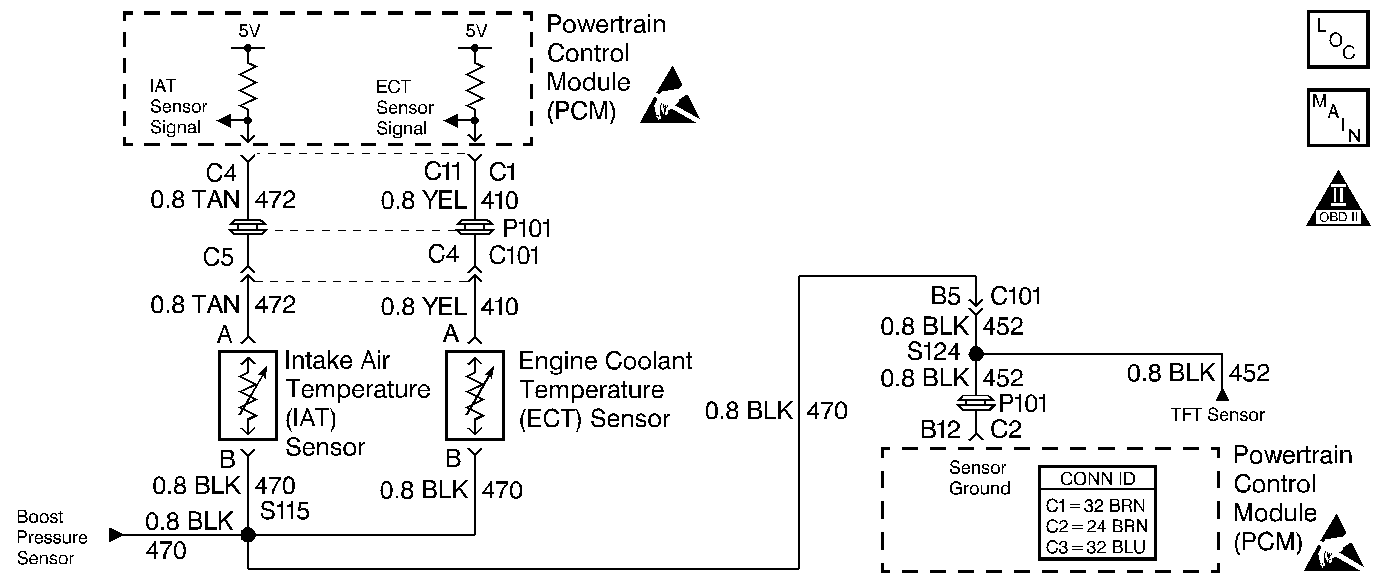
Circuit Description
The Intake Air Temperature (IAT) sensor is a thermistor that controls the signal voltage to the PCM. When the air is cold, the sensor resistance is high, therefore the PCM will see a high signal voltage. As the air warms, the sensor resistance becomes less and the voltage drops.
Conditions for Running the DTC
The engine coolant temperature is less than 42.5°C (109°F).
Conditions for Setting the DTC
| • | The intake air temperature is more than or equal to 152°C (304°F). |
| • | The conditions were met for 2 seconds. |
Action Taken When the DTC Sets
| • | The PCM illuminates the Malfunction Indicator Lamp (MIL) on the second consecutive drive trip the diagnostic runs and fails. |
| • | The PCM records the operating conditions at the time the diagnostic fails. The first time the diagnostic fails, the Failure Records store this information. If the diagnostic reports a failure on the second consecutive drive trip, the Freeze Frame records the operating conditions at the time of the failure and updates the Failure Records. |
Conditions for Clearing the MIL/DTC
| • | The PCM will turn the MIL off after 3 consecutive trips without a fault condition. |
| • | A History DTC clears after 40 consecutive warm-up cycles, if this or any other emission related diagnostic does not report any failures. |
Use a scan tool in order to clear the DTCs.
Diagnostic Aids
Check the harness routing for a potential short to ground in the signal circuit. The scan tool displays the intake air temperature in degrees celsius. Refer to Symptoms . A skewed sensor could result in poor driveability complaints. Refer to Temperature Versus Resistance .
Test Description
The numbers below refer to the step numbers on the Diagnostic Table.
-
This step determines if P0112 is a hard failure or an intermittent condition.
-
This test will determine if the PCM can recognize an open sensor.
-
This step will determine if the problem is a malfunctioning PCM or if the signal wire is shorted to ground. The normal resistance across the IAT sensor connector harness is 4000-5000 ohms.
Step | Action | Value(s) | Yes | No |
|---|---|---|---|---|
1 |
Important: Before clearing any DTCs, use the scan tool Capture Info function in order to save Freeze Frame and Failure records for reference. The control module's data is deleted once the Clear Info function is used. Was the Powertrain On-Board Diagnostic (OBD) System Check performed? | -- | ||
Is the IAT display more than or equal to the specified value? | 151°C (303°F) | |||
Does the IAT display a temperature that is colder than or equal to the specified value? | -30°C (-22°F) | |||
Is the resistance at the specified value? | ∞ | |||
5 | The DTC is intermittent. If no additional DTCs are stored, refer to Diagnostic Aids. If any additional DTCs were stored, refer to those tables. Are there additional DTCs stored? | -- | Go to the Applicable DTC Table | Go to Diagnostic Aids |
6 | Repair the short to ground in the IAT signal circuit. Refer to Wiring Repairs in Wiring Systems. Is the action complete? | -- | -- | |
7 | Replace the IAT sensor. Refer to Intake Air Temperature Sensor Replacement . Is the action complete? | -- | -- | |
8 |
Important: The new PCM must be programmed. Refer to Powertrain Control Module Replacement/Programming . Replace the PCM. Is the action complete? | -- | -- | |
9 |
Does the scan tool indicate the diagnostic Passed? | -- | ||
10 | Does the scan tool display any additional undiagnosed DTCs? | -- | Go to the Applicable DTC Table | System OK |
